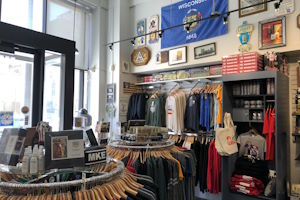2006-11 Vital Source Mag – November 2006
My Morning Jacket @ The Riverside Theater
By Caz McChrystal + Photos by Kat Berger The Riverside Theater (GO HERE to see more photos from the show) My Morning Jacket presented a perfect specimen of an elusive form at the Riverside Theater this past Tuesday night, the modern rock concert. But it is difficult to tell what a rock & roll concert is supposed to look like circa 2006. Decades of formulaic mayhem have littered the genre with beefed-up boredom and created a vacuum. The days in which a rock band’s greatness was measured by its ability to roll into a city like Rommel and conquer a submissive audience waiting to be played at are over. Rather, My Morning Jacket exploded the notion of what a rock concert is by playing to a rapt audience and treating the show as if it was a fragile being to be nurtured and coaxed out into the open. By the time the lights at the Riverside had gone black and MMJ emerged to open with “Wordless Chorus,” the crowd was already on its feet and moving along with the intelligently complicated rhythms. And it stayed that way for the nearly two hours that MMJ played. The first quarter of the show steadily built upon itself, reaching a high point with the reggae nod “”Off the Record.” The tune’s intro, a direct quotation of the seminal Hawaii Five-O opening riff thawed-out the mid-November crowd, warming up the audience before cooling it down with a run of slower-paced songs. The downshift to slower, searching improvisations broke down the rock show format, in which slower songs usually get tossed in only sporadically, and then only to give the drummer a brief respite. Here, it felt as though the band wanted to give the audience a chance to regroup, and it was well timed. Although some of these extended instrumental breaks noodled a little too long, MMJ never lost the audience. Coming out of this mellow and spacey section, MMJ slid into “Golden,” an archetypal country song off the It Still Moves record. For that song, guitarist Carl Broemel sat before a pedal steel and belted out one of those heartbroken but hopeful Nashville harmonies that felt down home and far out at the same time. This wonderful slide playing, accompanied by the plaintive vocals of Jim James, drove home the fact that MMJ is not just a group of guys who plays instruments, but musicians who not only take pride in their craft, but take it seriously. My Morning Jacket ended its show with the anthemic “Mehgeetah,” which came at the close of a half hour long encore. The impact of the show, however, did not flow from any single song they unexpectedly pulled out or effectively performed, it came from the overall arc of the evening. The concert seemed to ebb and flow, rocking with high intensity for periods only to draw back into esoteric musical self-searching in other parts. The mood would change within some songs, and sometimes without any discernible […]
Nov 27th, 2006 by Vital ArchivesGive ‘Em Hell, Harry
By Peggy Sue Dunigan Speaking directly, loudly and customarily cursing, Harry S. Truman’s voice and words ring shockingly true and remain relevant in the production of Give ‘Em Hell, Harry that opened at the Boulevard Ensemble Studio Theatre November 8. The audience in the packed space greatly appreciated those words, generously sprinkled with humor and truth, both of which marked Truman’s life. Moving through the time and space of Truman’s adult years on stage, Don Devona aptly caries the one man show. Dapper in a taupe double breasted suit, Devona appears both presidential and genuinely familiar, although slightly frail. The production builds steam through the second act as Truman reminisces about the “whistle stop” campaign of 1948, ending vibrantly as he struts with his walking cane on the streets of his hometown Independence, Missouri. Opening on the day after an election that witnessed the Democrats making stunning gains, Give ‘Em Hell, Harry surprises with the timelessness of the truths expressed. Truman begins as he describes his first political campaign for county judge of Jackson County (“a new war of words instead of guns” ) after returning from France in World War I. Continuing through to World War II, Truman again reflects on after only 86 days as the 33rd President, thinking, wrestling with the decision to “drop the bomb.” He claims, “Options… didn’t have any options. Thought it was going to end the war. Dropped one. Dropped another. They capitulated. Would do the same damn thing if I thought it was going to end the war. Waiting for someone to apologize for Pearl Harbor.” As it is for politicians today, war was consistently on his mind. And facing war for a third time as he utters these thoughts on Korea: “Damn Korea thing…blowing up in our faces.” Truman again could well be verbalizing current events, such as North Korea’s recent experiments with their own nuclear bomb in 2006. However, it’s the Korean War of 1950 to which he’s referring. “We weren’t there to win. What were we there for? To stop something. Preserve the peace of the world.” Has this been said before? Or is he speaking to the reality of war and “the innocent lives of American men and women are being destroyed. It’s a tragedy.” A tragedy, similar to 1940, 1950, decades later in Iraq; the same truths exist. As the play continues traveling through Truman’s life, whether spewing political or personal wisdom, the audience is left wondering what, if anything, has changed. For Truman addresses corruption in business, dirty politics, racism, falsified bids, public housing and the minimum wage. All timely subjects for any current political arguments. Speaking like a true Democrat to the Republicans 60 years ago, Truman says, “I’m not giving ‘em hell. I’m just telling them the truth to make them feel like they’re living in hell.” VS Give ‘Em Hell, Harry runs through November 19 at the Boulevard Ensemble Studio Theatre in Bay View. Tickets: $20.00 by reservation. Please call 414-744-5757 for details.
Nov 15th, 2006 by Peggy Sue DuniganNot Now, Darling
By Russ Bickerstaff With all the right treatment under the right conditions, life can be a late 60s British sex farce. One needs only gather the right adults together and get them to be a bit more fictitious than usual. No elaborate sets are needed. Costuming need not be extensive. The comedy comes naturally. With this social dynamic in place, RSVP Productions’ Artistic Director Raymond Bradford delves into an enjoyable evening of theatre as co-director and co-star in Ray Cooney and John Chapman’s 1969 hit comedy Not Now, Darling. Bradford himself stars as a diligent, honest furrier named Arnold Crouch. Alan Stevenson co-stars as his business partner Gilbert Bodley. Crouch, being a womanizing adulterous husband with a suspicious business sense, is quite the opposite of the virtuous Crouch. Crouch finds his morals slipping in a chain of events brought about when Bodley attempts to give a young married woman the gift of a very expensive fur coat. The chain of events is written to rush through the play in a blinding flurry. This is a comedy of escalation. With some 11 people in the cast swimming through the tiny stage at the Astor Theater, RSVP does a pretty good job of keeping things quickly enough to spark some laughs. The momentum may slip in places, but it rights itself quickly enough to shoot through a relatively entertaining evening of comedy. The roles are all written as exaggerated comic characters and the RSVP cast seems to have a really good time performing them. Kelly Simon plays the young Janie McMichael, hopeful recipient of Crouch’s gift coat. Simon plays Janie with the surreal affectations of a grossly amplified material girl. Earl Scharnick seems suitably confused as her husband Harry, who is also in an extramarital affair with an attractive young woman named Sue (played by Anne Miller) whose husband occasionally storms through the action, played by Ken Dillon. Things, of course, get even more complicated with Bodley’s wife Maude (Marcee Sturino) coming back early from vacation to find things in disarray. Notable supporting performances around the edges include Cynthia L. Paplaczyk as Bodley & Crouch’s oddly comic secretary and the tiny, talented Marilou Davido as a young, overly-friendly employee of the business. Rather than setting the production in a late 1960s England, Bradford has opted for a more ambiguous “Modern Metropolitan City” in the present. This spares the audience of having to hear a variety of different mid-western attempts at British accents, which makes the production all the more enjoyable. For anyone familiar with the style and pacing of dialogue in a British comedy however, it’s a bit disorienting. That ineffable use of silence, inflection and sarcasm with a hint of exaggeration seems to have been lifted from the script along with the accents. This distraction doesn’t detract enough from the comedy to be anything other than subtly confusing to those familiar with the genre. This is by no means deep or deeply moving comedy. Closing just one week before the Christmas […]
Nov 15th, 2006 by Vital ArchivesTrudy Blue
By Jill Gilmer “Can I speak to them?” Ginger Andrews asks, referring to her family as she watches them weep at Ginger’s funeral. She poses the question to a fellow angel who is watching the funeral with her from their heavenly perch. “No,” the other angel replies. “That is what your life was for.” Talk to the people you love while you are still alive. This is the simple yet provocative message of Trudy Blue, a play by Pulitzer Prize-winning playwright Marcia Norman presented by the Dramatists Theatre. The play is based on Ms. Norman’s personal journey after she learns that she has two months to live. Like Ms. Norman, lead character Ginger Andrews, a novelist, later learns that her doctor’s diagnosis of lung cancer is wrong. Thus, she will have to continue living her dreary life, a fate more devastating to Ginger than the death prediction. The play takes place nearly entirely in Ginger’s mind as she contemplates conversations with her family and with Trudy Blue, a character from one of her novels who also represents Ginger’s alter ego. The play mingles these “real conversations with imaginary people and imaginary conversations with real people” interchangeably, an intriguing technique that is at times confusing to the audience. Despite the erratic effectiveness of this dramatic technique, the play succeeds in illustrating the results that ensue when a writer channels painful thoughts and feelings into fictitious characters and stories instead of sharing them with the people involved. As a series of surprising revelations unfold over the course of the play, the audience witnesses the potential damage to relationships when a person conceals their true persona from the people they love. It’s a dynamic that is likely experienced by introverts and artists of many types. The Dramatists Theatre’s production of Trudy Blue is a commendable adaptation of a difficult story. Unfortunately, its overall impact is diminished by an inexperienced cast, which offers the audience minimal assistance in understanding or caring about the two central characters, Ginger and her alter-ego, Trudy Blue. A tedious first act may lose some audience members while the stage is set for the more compelling second half. This notwithstanding, a play of this complexity is an impressive accomplishment for a theatre company in its second season, operating on a shoe-string budget. (The actors were not paid, and artistic director Marjorie Shoemann also manned the box office and snack bar.)VS Trudy Blue is the second installment in the Dramatists Theatre’s series of plays by Marcia Norman. Each season, the company showcases the work of a single playwright. Trudy Blue runs through Saturday, November 18 at the Marian Center for Non-Profits, 3211 S. Lake Drive. Tickets are $16. For reservations, please call 414-243-9168.
Nov 15th, 2006 by Vital ArchivesThe Hold Steady
By DJ Hostettler Once upon a time back in the 1980s, there was a genre called “alternative.” It’s hard to believe these days, but back in the day, labeling a band “alternative” actually meant it was an alternative to what you’d hear on your local corporate top-40 radio station. Siouxsie and the Banshees didn’t sound like Pat Benatar, and that was a beautiful thing. Then when “alternative” became meaningless in the 90s, “indie rock” sprung up to remind us that no, Sebadoh doesn’t sound like Pearl Jam either. These days, indie rock still doesn’t sound like what you’ll hear on the local Top 40 station, but thanks to The Hold Steady, it definitely sounds like your local classic rock station. It’s an odd state of affairs when Vagrant Records’ hottest new acquisition sounds like Bob Seger with Thin Lizzy’s guitar solos, but that’s not necessarily a bad thing either. Boys and Girls in America is the perfect title for The Hold Steady’s third full-length. The no-frills hard rock herein evokes images of Midwestern blue-collar Night Moves-style Americana, while Craig Finn’s trademark love-‘em-or-hate-‘em spoken-sung vocals spin yarns about modern boys and girls going to “all ages hardcore matinee shows” (the crazy catchy “Massive Nights” ) and apparently taking lots and lots of drugs (just about every song on the album), giving the retro soundtrack distinctly modern subject matter. The constant theme of teenagers in love taking loads of drugs is worn thin by the end of the record – “Chillout Tent’s” dueling he-said/she-said boy/girl choruses are pretty annoying, to be blunt – but overall, Boys and Girls in America is solid, rockin’ and has a few potential classics (I dare you to not hum along with the “woah-woahs” in “Chips Ahoy” ) without sounding as stale as the classic rock it references. VS
Nov 15th, 2006 by Vital ArchivesNovember Record Releases
By Erin Wolf November 7 …And You Will Know Us By The Trail of Dead So Divided Interscope Bowling for Soup The Great Burrito Extortion Case Jive Foo Fighters Skin and Bones Roswell/RCA JJ Cale & Eric Clapton The Road to Escondido Duck/Reprise Josh Groban Awake 143/Reprise Kenny G I’m in the Mood for Love: The Most Romantic Melodies of All Time Arista Talib Kweli Ear Drum Blacksmith/Warner The Long Blondes Someone to Drive You Home Rough Trade The Magic Numbers Those the Brokes Heavenly/EMI MoZella I Will Maverick/Warner ODB A Son Unique Damon Dash Music SugarLand Enjoy the Ride Mercury Keith Urban Love, Pain & the Whole Damn Thing Capitol Nashville Dionne Warwick Me & My Friends Concord Lucinda Williams The Knowing Lost Highway November 14 Army of Anyone self-titled The Firm/EMI Bad Astronaut Twelve Small Steps, One Giant Disappointment Fat Wreck Chords Depeche Mode The Best of Volume 1 Sire/Reprise The Game Doctor’s Advocate Geffen Jamiroquai Greatest Hits Epic Luciano Pavarotti The Ultimate Collection Universal Nanci Griffith Ruby’s Torch Rounder Maroon5 TBA Octone/J Brian McKnight 10 Warner Mya Liberation Universal Motown Joanna Newsom Ys Drag City Joan Osborne Pretty Little Stranger Vanguard Robert Plant Nine Lives Rhino Damien Rice 9 Warner Styles P Time is Money Ruff Ryders Sublime Rarities Geffen Tamia Between Friends Gallo Record Company/Image Tenacious D Tenacious D in the Pick of Destiny Epic Kenny Wayne Shepherd 10 Days Out: Blues From a Backroad Reprise Neil Young Live at the Fillmore East 1970 Reprise Yusuf (formerly Cat Stevens) An Other Cup Ya/Atlantic November 21 Patti Austin Avant Gershwin Rendezvous Crowded House Farewell to the World Parlophone Incubus Light Grenades Epic Jay-Z Kingdom Come Roc-A-Fella/Def Jam Killswitch Engage As Daylight Dies Roadrunner Oasis Stop the Clocks Epic Our Lady Peace A Decade Columbia Rock Star Supernova TBA Epic Snoop Dogg Blue Carpet Treatment Doggystyle/Geffen Sufjan Stevens Songs for Christmas Asthmatic Kitty Throwing Muses House Tornado (Remastered) Wounded Bird Tom Waits Orphans: Brawlers, Bawlers & Bastards Anti-/Epitaph Lee Ann Womack Finding My Way Back Home Mercury Nashville November 28 The Early Years self-titled Beggars Banquet
Nov 1st, 2006 by Vital ArchivesCaribbean cowboy
By Catherine McGarry Miller + photos by Kevin C. Groen At 19, Montana native Michael Morton was a mosh pit punk who also briefly studied art in Missoula. “I’d be hard-pressed to tell you what I was trying to say,” he admits of his found-object constructions. “I was young and trying to make statements, but was probably naïve, misinformed and shallow.” Growing up in Montana, Morton experienced home on the range and its wide open spaces. He spent much of his youth exploring the woods near his Helena home, rooting around deserted mines and abandoned shacks. An avid fan of grunge and industrial music, Morton in 1993 joined the “Montana Mafia,” slang for the mass migration of young Montanans to Seattle for the music scene and city life. Having worked in delis as a teenager, he cooked to finance his clubbing. “I learned to work fast – whatever you do, do it fast. I had a string of deli jobs and never diversified my portfolio.” His first job in Seattle at a high volume kosher deli taught the unruly youngster a lot about interacting with the public and conforming to strict kosher dietary laws. Later Chef Walter Pisano of Tulio Ristorante took a very green Morton, with an admittedly bad attitude, and mentored him into a reluctant professional. “This was the real deal,” Morton smiles, remembering. “I had just enough experience to get in the door. I’d worked in such undisciplined kitchens. This was my first real professional kitchen where I learned technique, presentations and vocabulary: about quality in food.” Under Pisano’s tutelage, Morton’s long locks gave way to a military coif and he calmed down enough to learn his craft. Risotto was a real trial. “It’s really good when done correctly, but there’s no way to fake it or hide. The trick to risotto is cooking it very slowly and to never walk away from it.” The lessons Pisano imbued stay with Morton. “He said, ‘You should taste everything but you should taste nothing,’ which means that you should be able to taste all the ingredients that contribute to a dish, but nothing should overwhelm it. He also talked about the ‘face of food.’ Looking at a plate you should be able to see all the ingredients. Like in a sausage, each ingredient should be in every bite and in proper proportion.” Friend John Dye lured Morton to Milwaukee in 2001 to work at Hi Hat as a cook. “Brunch had the volume and intensity of serving people who were hung over and hadn’t had their morning coffee yet. You spend six hours in a 120-degree box and you’re either going to kill each other or have a really good time.” Hi Hat Executive Chef Matt Post introduced him to the nuts and bolts of the business: costing, inventory management and processing employee paperwork. This summer, DJ and Cassie Brooks, who’d worked with Morton at the Hi Hat, hired him on as chef of their own new restaurant, Good […]
Nov 1st, 2006 by Cate MillerDance
By CATCH AS CATCH CAN Janet Lilly hosts an evening of work by her, Sean Curran, Heidi Latsky and Peter Sparling with the Danceworks Performing Company from Nov. 10 – 12. 414-277-8480 or www.danceworks1661.org. BLESSED OFFERINGS Ko-Thi Dance performs its annual harvest dance concert Nov. 10 – 11 at Alverno College’s Pitman Theatre. 414-382-6044 or www.ko-thi.org. IMPROSCAPING Susan Carter presents improvised choreography designed to create a visual landscape. A one-woman dance featuring live jazz guitar Nov. 12 and 19 at the Walker’s Point Center for the Arts. 414-871-1523 or www.carterproductions.com. INCA SON The rich, colorful dance and music of the native cultures of the Andes comes to Wisconsin Lutheran College on Nov. 14. 414-443-8802 or www.wlc.edu/arts. IN FROM THE CHILL: YOUR MOTHER DANCES Danceworks hosts an evening of new works featuring Elizabeth Johnson, David Parker, Sara Hook and more. Nov. 17 – 19 at the Danceworks Studio Theatre. 414-277-8480 or www.danceworks1661.org. VARIOUS STATES OF UNDRESS Wildspace Dance performs new pieces by Artistic Director Debra Loewen and Katie Sopoci. Nov. 29 – Dec. 2 at the Stiemke Theater. 414-271-0712 or www.wildspacedance.org.
Nov 1st, 2006 by Vital ArchivesJust the way it is
By Jon Gilbertson On a late October afternoon, Hank Williams III is touring the East Coast and feeling poorly – not because of the fondness for John Barleycorn that supposedly afflicts all in his line, but because of the more banal bugs that don’t cure easily over a long stint on the road. He isn’t whining about a head cold, though. “I chose the hard road as opposed to the easy road a long time ago,” he mutters across the wires. “I got that drive and that’s what keeps me going.” Like much of what Hank III has said since he stepped directly into his legacy more than a decade ago, those lines require only a little editing to make fine country song refrains. But he’s spent a great deal of time mixing up that legacy with the punk rock and heavy metal he’s loved ever since he was a kid. “People do realize that I’m into many things besides country,” he says. “People see a realness. That’s what I hear a lot.” But not every fan shows equal appreciation for each of his facets. “There’s a certain breed out there that loves Slayer and David Allan Coe,” Williams says. “It might come from the same place, but some of the fans just don’t get it. There’s a bunch of snobs and you’ll never be cool because you’re not punk or country enough for ‘em. Each little group has its thing.” If Hank Williams III has a thing, then that thing would probably be lifelong defiance. Born Shelton Hank Williams in Nashville in 1972, he didn’t really get to know his father, Hank “Bocephus” Williams Jr., because he wasn’t around. While the two have crossed paths more often in recent years, it should be noted that during our entire interview, he referred to his father only once; as “Hank Junior” at that. Hank III didn’t really know his musical lineage, either, and was content to smoke weed and rock hard until a crushing and sudden need to make regular child-support payments sent him to the tourist town of Branson, Missouri to earn his keep imitating his grandfather. (The resemblance, vocally and physically, is eerie, and has been commented on so much elsewhere that it need not be dwelled on here.) Now, rather than imitating his grandfather, he seems to be cutting a parallel path, at least in terms of having a difficult relationship with the music industry. In 1996, Hank III signed with Curb Records and has been head-butting with the label and its head, Mike Curb, ever since. “I’ve been fighting in court to get off that label forever,” Williams says. “This goes back to a family name, back to spite. This is people holding us back. There are all these rich-ass motherfuckers who don’t want to let me go, even though they don’t understand me and will not market me.” It didn’t help that the label’s first use of Hank III was to put his voice together with […]
Nov 1st, 2006 by Vital ArchivesNovember 2006
By IN:SITE Insight I had no idea IN:SITE would be on the cover of VITAL! This is fantastic! Thank you so very much (Covered, October 06). I love the photo on the cover. It is exactly what IN:SITE is about: SITE-SPECIFIC temporary public art. I was so glad that the focus was on the artists, the collaboration with business groups and the reactions of people on the street. Amy worked hard and it shows. And the whole texture of the piece with Amy mentioning the SOUND of “Super Subconscious” speaks to her background as a poet. Bravo! Pegi Taylor Lauds for Leiter I thought the article [on Saul Leiter] was great (Interview, October 06). It made me laugh out loud a few times. You really depicted his personality very well. He’s a unique individual, so I know this is not easy. Margit Erb Howard Greenberg Gallery New York To VITAL: Great article on Saul! You really capture his endearing demeanor and communicate the significance and originality of his work. I’ve forwarded it on to him, and I’m sure he’ll be pleased. All the best, Lisa Hostetler Assistant Curator of Photographs Milwaukee Art Museum To VITAL: I went to the most amazing event last evening thanks to you and your magazine. I was looking through VITAL when my husband said he wanted to see a movie or a play. I was not in the mood for either and was just finishing up reading your article, “Shoot from the hip,” when I saw the ad for “Milwaukee Street, Milwaukee” at the Milwaukee Art Museum. We went and – Wow! It was the most amazing exhibition I have seen in a really long time. Not only were Saul Leiter’s photos so pure and wonderful to look at, but so simple and so relatable. In addition to Saul’s exhibit, Cedar Block’s exhibit of local photo artists was really inspiring. I have to say that John Miller’s photo montage in the rain was done in the same feeling as Saul Leiter’s [work]. It’s great to see local artists being exhibited in the very public domain of the MAM. Thanks so much for a really great date! Toni Milwaukee Open Season on Butgereit? Thanks for taking the time to review Jeremy Enigk’s new record (Music Reviews, October 06). It’s interesting, though, that Ms.Butgereit [the reviewer] felt Enigk’s use of melancholia derailed the album. It makes me wonder if she ever heard 1996’s Return of the Frog Queen, Enigk’s first solo record (which she failed to mention) and what she thought of that. I, for one, feel like both of these albums are fantastic, despite the tone and pace, and aren’t “exhausting to listen to and difficult to enjoy,” as she puts it. By her estimation then, Nick Drake’s Pink Moon, Lou Reed’s Berlin, Sebadoh’s The Freed Weed and virtually every Smiths album no doubt “becomes overwhelmingly grating as the songs tick by,” simply because they dabble in the depressing. What other artists should we recommend steering […]
Nov 1st, 2006 by Vital Archives














